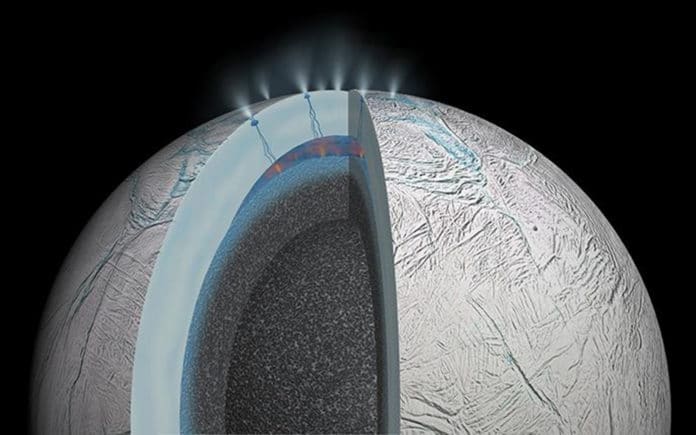The presence of methane gas on other planets indicates either microbial life or a geochemical process such as volcanism or hydrothermal activity.
Recently, the Cassini-Huygens probe made an unexpected detection: a relatively high concentration of specific molecules associated with hydrothermal vents on the bottom of Earth’s oceans.
While flying through the giant water plumes erupting from Enceladus and sampling their chemical makeup, the probe has detected a high concentration of dihydrogen, methane, and carbon dioxide. The amount of methane found in the plumes was particularly unexpected.
Based on the detection, scientists from the University of Arizona and Paris Sciences & Lettres University have suggested that there might be a methane-producing process is likely at work in the hidden ocean beneath the icy shell of Saturn’s moon Enceladus. The discovery of methane indicates the presence of life on Saturn’s moon Enceladus.
This is not the first time that possible signs of life discovered on Saturn’s moon. Previous studies have suggested the possible signs of alien life on Titan, Saturn’s largest moon. Saturn’s moon Titan features rich atmospheric chemistry and dynamic surface morphology driven by seasonal rainfall and the cycling of predominately methane and ethane.
In this study, scientists used mathematical models to calculate how different processes, including biological methanogenesis, might explain the Cassini data. Using the mathematical model, scientists analyzed Cassini plume data and model the possible processes that would best describe the observations.
They conclude that Cassini’s data are consistent either with microbial hydrothermal vent activity or with processes that don’t involve life forms but are different from those known to occur on Earth.
Scientists observed Enceladus‘ plume composition due to several chemical and physical processes taking place in the moon’s interior.
To start with, scientists evaluated what hydrothermal production of dihydrogen would best accommodate Cassini’s observations. Regardless of whether this production could give enough “food” to support a populace of Earthlike hydrogenotrophic methanogens.
To do that, they fostered a model for the populace elements of a speculative hydrogenotrophic methanogen, whose thermal and energetic niche was designed according to known strains from Earth.
Scientists ran their model to determine a given set of chemical conditions, such as the dihydrogen concentration in the hydrothermal fluid, and temperature would provide a suitable environment for these microbes to grow. They observed the effect of a hypothetical microbe population on its environment.
Regis Ferriere, an associate professor in the University of Arizona Department of Ecology and Evolutionary Biology, said, “In summary, not only could we evaluate whether Cassini’s observations are compatible with an environment habitable for life, but we could also make quantitative predictions about observations to be expected, should methanogenesis occur at Enceladus’ seafloor.”
The results suggest that even the highest possible estimate of abiotic methane production—or methane production without biological aid—based on known hydrothermal chemistry is far from sufficient to explain the methane concentration measured in the plumes.
Ferriere said, “Obviously, we are not concluding that life exists in Enceladus’ ocean. Rather, we wanted to understand how likely it would be that Enceladus’ hydrothermal vents could be habitable to Earthlike microorganisms. Very likely, the Cassini data tell us, according to our models.”
“And biological methanogenesis appears to be compatible with the data. In other words, we can’t discard the ‘life hypothesis’ as highly improbable. To reject the life hypothesis, we need more data from future missions.”
According to scientists, the study offer guidance for studies aimed at better understanding the observations made by Cassini and that it encourages research to elucidate the abiotic processes that could produce enough methane to explain the data.
Journal Reference:
- Antonin Affholder et al., Bayesian analysis of Enceladus’s plume data to assess methanogenesis, Nature Astronomy (2021). DOI: 10.1038/s41550-021-01372-6
